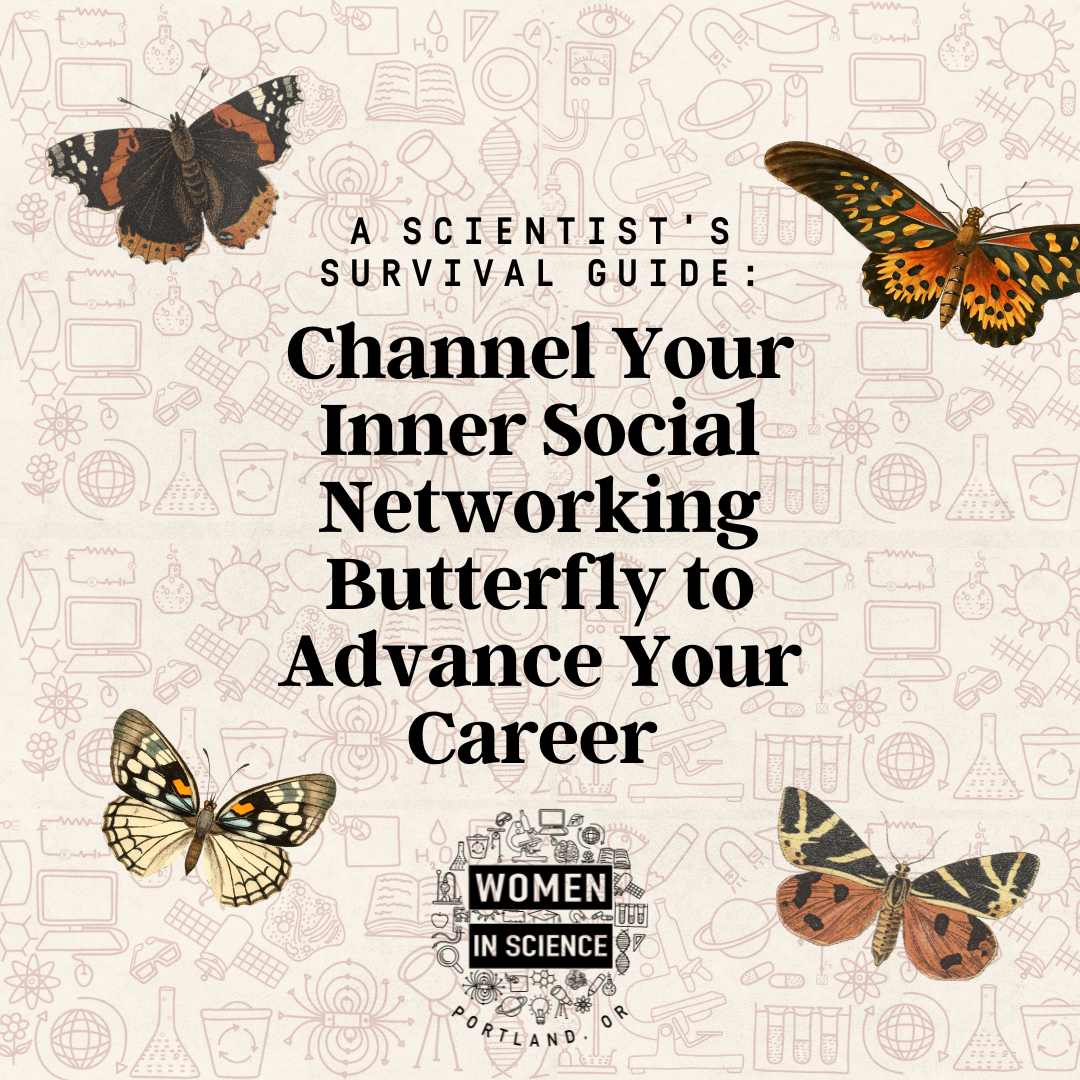Channel Your Inner Social Networking Butterfly to Advance Your Career
You’ve probably heard this phrase a million times: It’s not about what you know, it’s about who you know. While that might not be the easiest information to accept, it’s true, especially when it comes to career development.
According to a recent survey, 85% of jobs are filled through networking and 70% of jobs are never publicly posted.
If that’s not enough to convince you of the power of networking:
70% of employees landed their current role through networking
79% of Americans agree that networking was key to landing their current role and continues to be a vital component of their career progress
Despite making up only 7% of the candidate pool, employee referrals account for 40% of all new hires
Social networks are an incredibly powerful resource for career development. As the gender gap continues to expand, having a strong, well-connected social network is especially crucial for women looking to advance in their career.
In addition to helping you land your next job, social networking can provide an excellent opportunity to share knowledge and ideas, offer and receive advice and support, learn new insights into your industry (or a different industry if you’re looking to switch fields), and enhance your credibility and visibility amongst other professionals in your field.
Regardless of whether you’re looking to make new connections, learn new ideas, or find a new job, having a strong, well-connected network of professionals in your corner will be key to gaining greater access to new and valuable information and opportunities now and in the future.
How to start networking?
We live in a world where the ability to connect with others is infinite. This means that the opportunities to network are also infinite, and potentially overwhelming if you don’t know where to start.
To help you manage your time and energy along the way, consider the following:
Dedicate a set amount of time for networking
Building a strong network takes time. Determine which days and time of day you’re best able to network with others. This can help keep you accountable and ensure consistency in your networking.
Determine your preferred mode of networking
Do you like meeting people in-person, online, at large networking events, or more intimate gatherings? Different personality types have different tolerances for social networking. Try to find the networking option that works best for you.
Start close to home
Tap into the networks of your friends, family, and coworkers. Having a mutual connection can make it easier to make introductions and find commonality with new connections.
Identify your goal(s) when building your network
Are you looking to make new connections, learn new information, find potential referrals for a job? Knowing your goal in networking will keep you focused on the type of people you reach out to, the kinds of events you attend, and how you present yourself with your new connections.
Who to contact?
Classic ways to make new connections include attending conferences, signing up for mixers, or joining an alumni group. But with today’s technology, networking doesn’t have to stop after the event ends. You can meet and stay in touch with your connections via social networking platforms, such as LinkedIn.
LinkedIn offers a vast user base of companies, organizations, and employees from all fields worldwide. People who you’re interested in contacting likely fall into one of the following categories:
Employee: This is someone who works at a company of interest. They may be someone in a role you’re interested in or someone who works closely with a role of interest. These individuals can provide valuable insight into the responsibilities of a job and the company culture.
Internal Recruiter: Internal recruiters are typically at larger companies and are dedicated to finding candidates for specific roles within the company. They might be department specific (medical writing, sales, clinical research). They are usually the first point of contact for job candidates and will screen applications before sending them to the hiring manager.
External Recruiter: External recruiters typically work for a recruiting or staffing agency that works with larger companies to hire candidates to fill a certain role for that company. External recruiters tend to focus on industry-specific roles and don’t get paid until their candidate is hired for a role.
Talent Acquisition: Talent acquisition staff are similar to recruiters, but instead of looking for candidates to fill specific roles, they seek out top talent to fill gaps in the organization.
Hiring Manager: At some companies the hiring manager is one of your first points of contact in an interview. They screen candidates for fit with the company and role. The hiring manager may also be your potential boss or boss’ boss.
To determine with whom you’d like to meet, research companies in your field or job openings of interest.
How to find new connections?
There are a few ways to find people on LinkedIn.
Search bar: This is a great option if you aren’t looking for people at a particular company. Type job titles of interest in the search bar. You can then filter by location, people, or even industry.
Company’s ‘People’ feature: Every company profile on Linkedin has a tab that lists all their employees. By clicking the ‘People’ tab on their profile you can search the entire list of people affiliated with that company. Refine your search by filtering for job title, location, university affiliation, etc.
“Meet the Hiring Team” option on job posts: This option is only available for LinkedIn Premium members. For ~$30/month, you can access information on the hiring team and any mutual connections you have with the hiring team that could serve as referrals.
How to introduce yourself to your new connections?
Before you start contacting people on LinkedIn, it’s important to understand that not everyone will accept your request or respond to your message. Apparently, only ~40% of recruiters respond to messages. That’s 100% alright! Below are some tips to increase that statistic and help you stand out.
Always include a message when you send a connection request
People are more likely to accept connection requests when they know why you’re contacting them.
Customize your message
Avoid sending a generic message. Leverage commonalities, such as mutual connections, associations, or fields. Let them know that you’ve done your research.
Be specific about why you’re contacting them
Are they in a particular job/field you’re targeting? Did someone refer you to them? Did you apply for a job at their company?
Set a call to action
What are you hoping to get from meeting them? If you want to set up a meeting, ask if they’re available for a brief meeting sometime this week or the next.
For templates of how to phrase introductory messages, check out this article.
Building genuine connections with your network
When it comes to social networking, it’s the quality that matters more than the quantity. Having a strong network of genuine connections allows for a deeper understanding of how each person can mutually benefit through sharing relevant information, expertise, and contacts.
Show interest in your connections
Networking should not be a one-sided transaction. It’s meant to be a mutually beneficial relationship whereby you and your connections can profit from knowing each other’s backgrounds, interests, and professional endeavors. So get to know your new connections. What is their career journey? What project(s) are they currently working on? What are the biggest challenges in their job? What are their professional goals?
Identify commonalities
Finding shared interests with your connections creates the foundation for genuine and meaningful conversations. Shared interests can include your industry or field, a hobby, or a shared value. Whatever it is, identifying these commonalities demonstrates your genuine interest in connecting with that person and provides an organic way for connections to flourish.
Gain trust
People can tell when someone is not being authentic and tend to respond less positively to those who are inauthentic. So be yourself. Share your career journey, your interests, your passions, and communicate with sincerity. Creating connections based on authenticity fosters trust and makes people more likely to stay in contact with you and help you in times of need.
Offer to help
Networking isn’t just about helping yourself. It’s about helping others, as well. This can be as simple as sharing an article with your network or introducing someone to a relevant contact. By showing that you are a valuable member of a social network, people will be more willing to help you when you need it.
Stay connected with your network
You never know when your network will come in handy. So keep in touch.
Send a follow-up thank you after each meeting
Ask if they know other contacts that would be helpful for you to speak with
Offer to share your contacts with them
Interact with their content on LinkedIn
Check in with them occasionally
Remember that building a strong social network takes time. So be patient and happy networking!
Additional Resources:
How I Learned to Love Networking as an Introvert
LinkedIn Networking: How to connect with hiring managers and recruiters
What Is an Informational Interview? And How to Make the Most of It
About the author: Natasha Fowler, Ph.D. (she/her) is an interdisciplinary clinical scientist who’s passionate about overseeing projects and programs that make science and healthcare more diverse, equitable, and inclusive and applying this knowledge to improve prevention, diagnostic, and treatment strategies. She’s also an advocate for scientists interested in non-academic careers. As the Communications Committee Chair of WIS and a volunteer on the WIS Professional Development Committee, Natasha loves connecting people with other people and with information that can aid in their career journey. Outside of work, Natasha is an avid traveler who loves connecting with others through food, different languages, and comedy.


